The following is my sketchbook response to the question:
What if Malaysia had a Jaeger (Pemburu) program?
First, some ground rules. In the spirit of the Pacific Rim movie:

And some additional rules I wanted to add:

We'll ignore the obvious technical and logistical barriers, and assume possibilities when we need to (as well as overlook my inability to draw feasible robots). Whenever there's a toss up between "that won't work" and "but it's darn cool anyway", the latter wins. For those less familiar with Malaysian terms, I've provided definitions that pop up when hovered over. However, there are still plenty of references that won't make sense to you. And any resemblance to real life persons or entities is purely coincidental - this is a work set in an alternate timeline.
"Lawan raksasa, bukan saudara".
- Rallying cry of the pro-PPM supporters during the developmental years of the program.
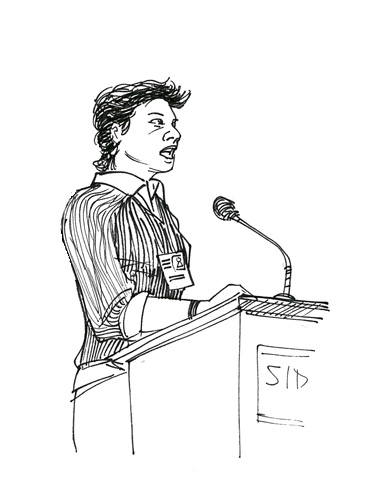
ABOVE: Datuk Maznah responding to comments from angry journalists.
History
Surely we can do as well as the other countries; surely we too can build robots.
Prime Minister Azam
As the rest of the world reeled from the initial kaiju attacks, PM Azam, not one to sit back when decisions could be made, proposed that Malaysia, in cooperation with its South East Asian neighbours, construct robots similar to what the Japanese and Americans were building. As befits the national language, they would be called Pemburu, instead of the German jaeger, and they would fend off any raksasa venturing into the region.
Naturally, people pointed out that there had not been any raksasa sightings in the SEA vicinity; also, was it worth it to start a Pemburu program, when we could just rely on the other countries building theirs? Who was lining their pockets with this project? Was this another attempt at patriotism?
Azam did not take kindly to such comments. And so the Pemburu program was established. Throughout every stage of development, its advocates and organizers faced critics and saboteurs, online and offline. Many were unhappy with the appointment of the Chief Scientist, Datuk Maznah Mohtar, claiming it was tokenism. Maznah's insistence on filling her ranks of advisors with people picked based on meritocracy was not well-received. Ultimately, despite Azam's initial assurance that he would back her, certain politically-aligned parties seized control of the pilot selection program during its infancy. The Pemburu staff, told to step aside for the sake of maintaining the peace, watched as their carefully prepared selection policies and criteria were set aside in favour of old-fashioned ways.
You can't just throw two people together and tell them they have to co-operate.
Chief Scientist Maznah
The first two pilots were picked through a program that spent as much on marketing as it did on the actual selection process. This was a spectacular failure as they ultimately failed to work with one another and crashed the inaugural Pemburu into Port Klang during its test run. However, this disaster had the benefit of silencing, temporarily, various groups that were lobbying for pilots based on racial criteria. Maznah and her team regained full control of every aspect of the PPM, and moved forward, this time with additional funding from sources eager to see the program succeed.

ABOVE: The 1Negara Pemburu in Port Klang.

A year later, when the revised program turned up candidates of surprisingly diverse backgrounds, this led to another round of bickering. Should Muslim women be allowed to pilot? What should their suits look like? Could two women pilot a Pemburu as well as two men? Could people with no military training or athletic background handle the stress of piloting the metal monsters?
Naturally, Malaysians of different backgrounds and persuasions took to the streets and online social media portals to express their support or opposition to different pilot candidates. Shown below is a selection of such groups. The constant effort needed to maintain their PR began to take its toll on the staff of the Pemburu program.
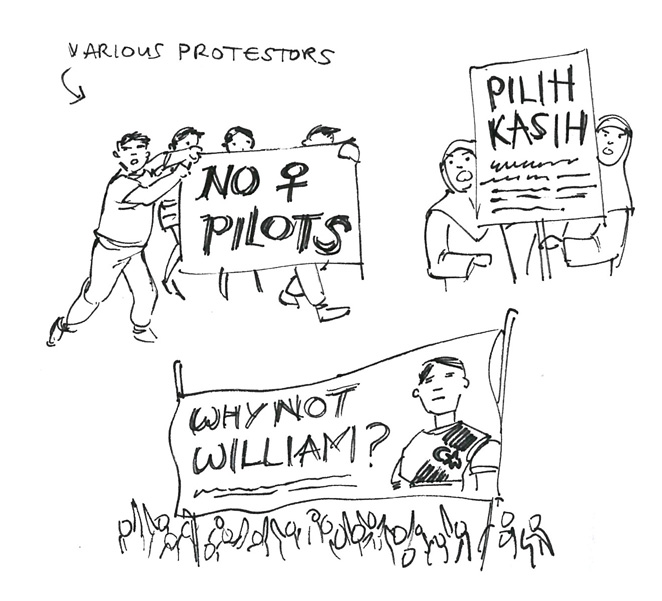
Early Events
However, the first raksasa (codename: Guppy) to wade into Malaysian waters in 2016 quickly put an end to the quarreling - it destroyed much of the Sabah and Sarawak coastline before an ASEAN force incursion took it down. And despite monthly protests against the Pemburu program (it was deemed excessive and a waste of resources), the second, then third Pemburus were constructed, and the first one repaired. When the next raksasa surfaced, Maznah's pilots rose to the occasion and demonstrated that they could indeed do their job.
Everyone loves Malaysian food.
Hanna Hakim, NASI LEMAK pilot
The pilots had been given generous allowances for input as to how their respective Pemburus would look like and function. This led to the extremely successful (and celebrated) NASI LEMAK, equipped with PEDAS missles and a SAMBAL blender arm contraption. The hulking KARIPAP PANAS with its various liquid spray weapons, a collaboration with the local biotechnology industry, followed.
One notable early battle was fought between KARIPAP PANAS and the raksasa codenamed Eelkind, which had swum up the Straits of Malacca and was wrecking havoc in Selangor. KARIPAP's pilots, noting that it was futile to fight a monster that originated from the sea in the sea, dragged the raksasa many miles inland and proceeded to beat it to a pulp in a deserted palm oil plantation while fascinated passengers on a nearby commuter train watched.
Because government funding could not sustain the rapid pace at which the program grew, corporate sponsors such as Nice, 100Add, and BerMeWah chipped in. Naturally, the early pilot suits had to carry their logos. After international scrutiny over each sponsor's business practices, the contributors decided to drop that requirement.
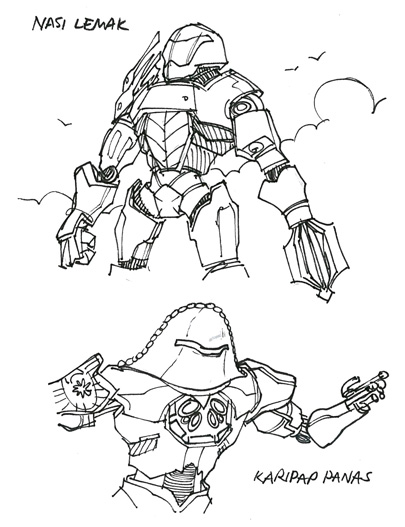
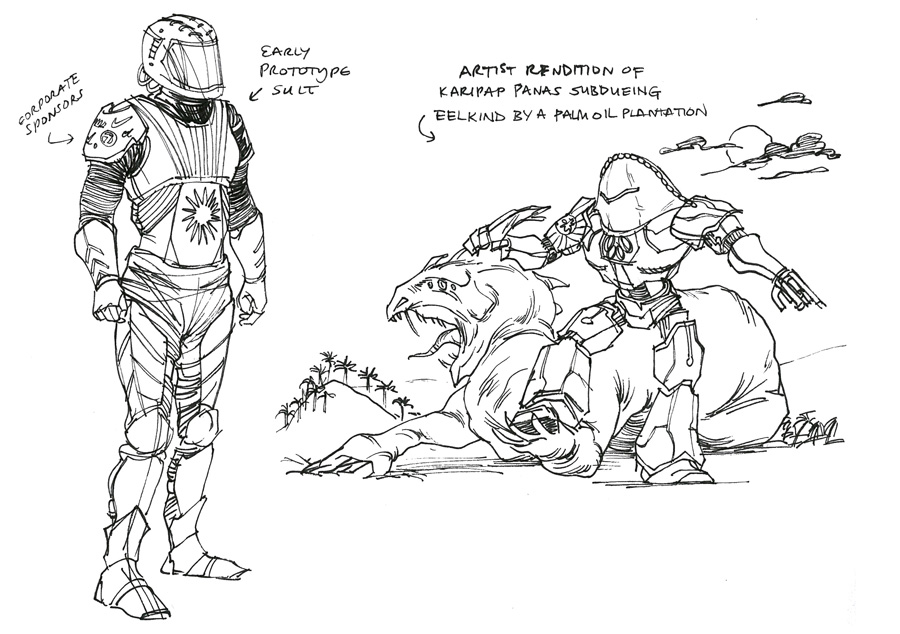
NASI LEMAK, KARIPAP PANAS, and MALAYSIA MAMPU (formerly 1Negara) served for a couple of years each before having to be decommissioned due to deteriorating parts and poor quality of build materials. Most of their pilots now enjoy a life of book talks and celebrity appearances, although some chose to fade into obscurity. NASI LEMAK's pilots, Hanna Hakim and Dewi Senja, often make school visits to encourage students to study science. KARIPAP PANAS sits in the National Collection and has been turned into an interactive exhibit that visitors can explore; recordings of its pilots, Ayob Hassan bin Ali and Che Dollah, are played as the guests walk through the cockpit. The cousins Wee Ken Win and Soh Ken Wee of MALAYSIA MAMPU do not regularly appear at events, although they have been spotted at various gerai enjoying a good dhosai rawa every now and then.
"Now it's the next generation's turn. I know they'll surpass us."
- Che Dollah, KARIPAP PANAS pilot.
Pemburu Teams
Despite its setbacks, the Pemburu program recovered to be successful by all standards. Its defining trait was that it was meant to be a model of the spirit of kerjasama. Compared to Jaegers constructed by other countries, each Pemburu was smaller by 20-30%, and would not have lasted long in battle by itself. However, the Pemburu administrators reasoned, having three Pemburu to a team would still be as, if not more, effective than one lone, large Pemburu.
At present there is one fully functional team in deployment.
TEAM KETUANAN MALAYSIA (est. 2020)



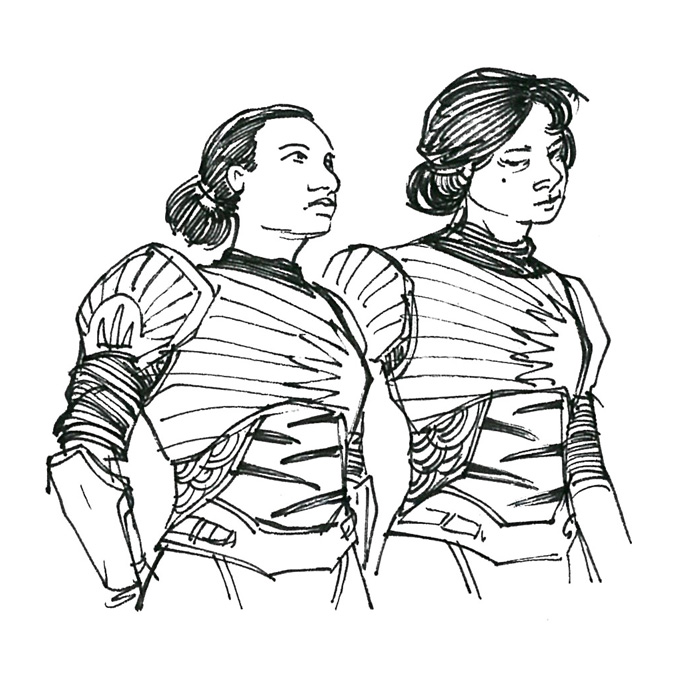
Tigress Prime
Sha Hasnah and Michelle Bulan make up the team driving the fearsome TIGRESS PRIME, known for its agility and ferocity in battle. The daughter of undocumented immigrants, Sha grew up in a children's shelter, through which she was able to get an education until she obtained citizenship and went to secondary school, where she studied under Michelle. The two formed a tenacious bond that serves them well in their pilot careers - TIGRESS PRIME holds the record for the most kills performed.
ATTRIBUTES
- Fast and relatively agile
- Acts on the offensive in team
- After securing raksasa in death grip, unleashes volley of projectiles from mounted guns
- Signature move is the Claw Flurry
NOTABLE DESIGN ELEMENTS
- Retractable Claws
- Built into feet and hands with the exception of the right arm.
- Titanium Keris
- Because why not.
- Rapid Fire Guns
- Mounted in panels along the torso and shoulders.
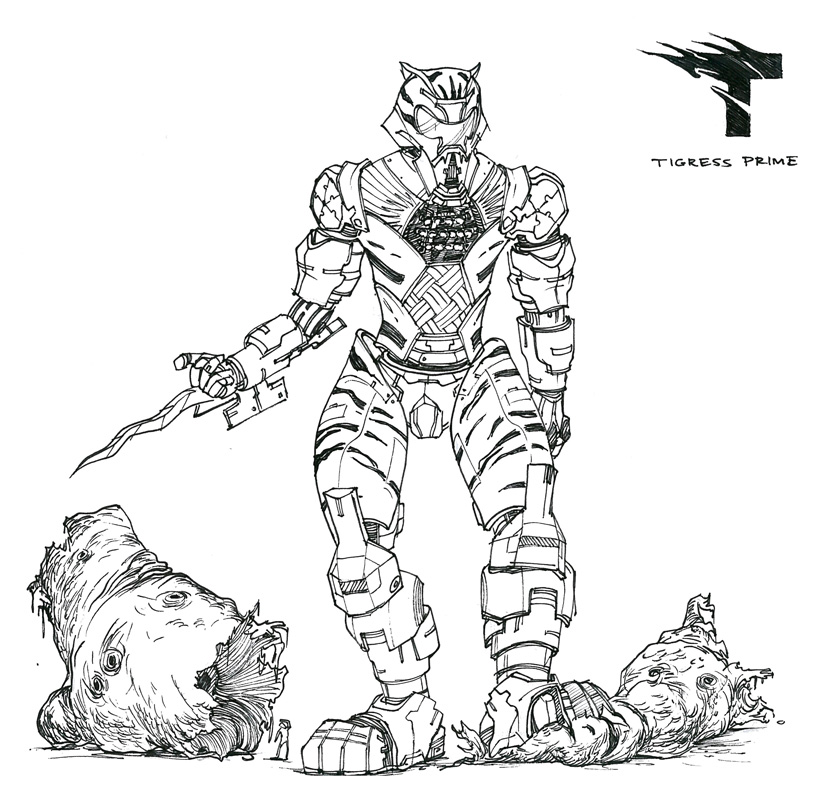
Macha Warrior
Terrence Tek Kum Pow and Raj Francis Veerasamy are the duo manning the aptly named MACHA WARRIOR. The two friends played competitive badminton in secondary school, later going on to the Olympics where they clinched two silver medals. MACHA WARRIOR has made a name for itself with its unconventional weapons as well as superior jumping power - no doubt it was modeled after its pilots' favourite sport. Since Raj also holds a PhD in AI Voice Synthesis, MACHA WARRIOR'S systems speak impeccable Manglish right down to the various intonations of 'lah'.
ATTRIBUTES
- Fastest on team; feet propulsion systems enable jumping
- Smallest Pemburu, normally used as bait
- Capable of stunning raksasa until team members arrive
- Signature move is the Match Point
NOTABLE DESIGN ELEMENTS
- Shuttlecock Missiles
- Launched by cannon on left arm; explosive and speedy.
- Electric Racquet
- Nicknamed the 'fly swatter'; generates electric field capable of halting raksasa in its tracks.

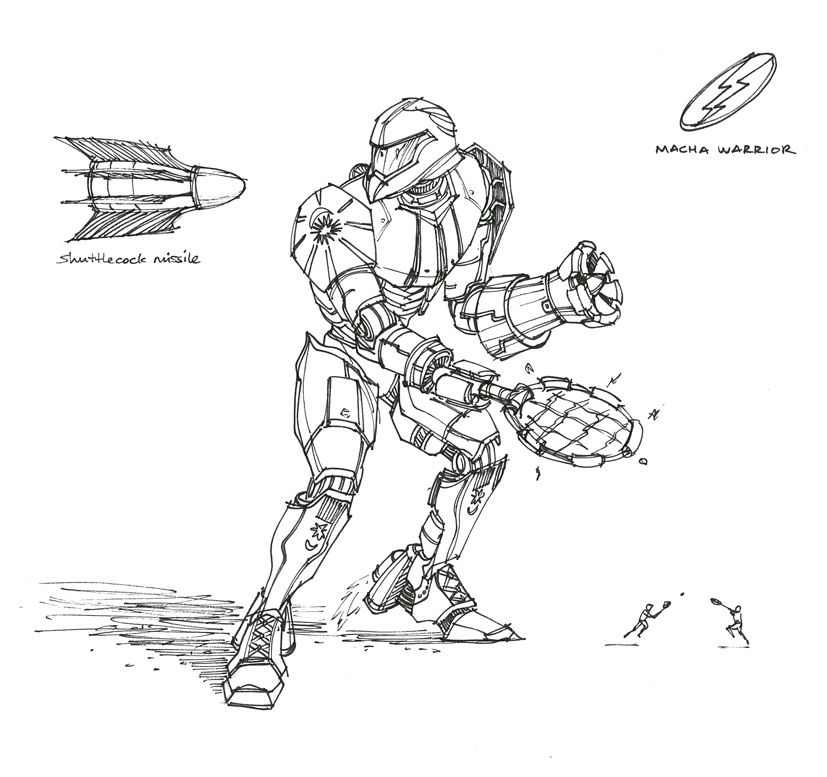
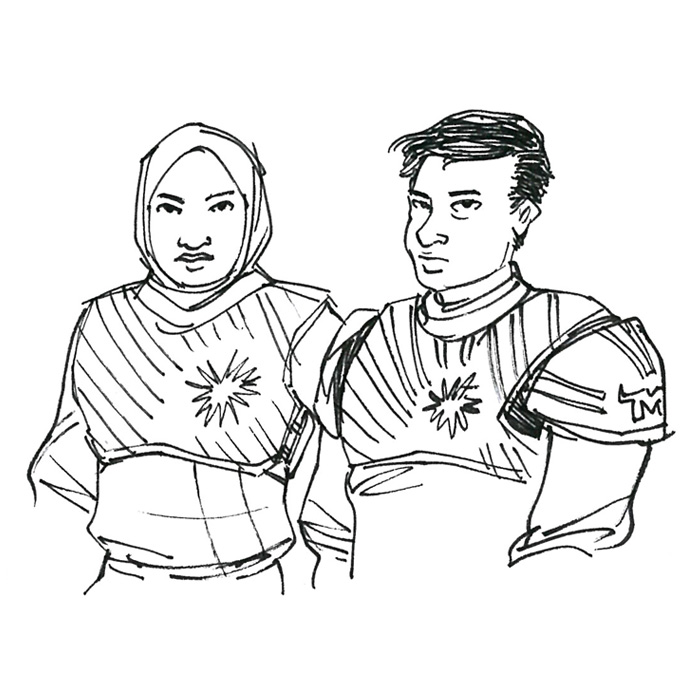
Menangkerbau
Salina Othman and Said Nazarin are the wife and husband behind the juggernaut MENANGKERBAU. Having grown up on farms before joining the military, they chose to adopt a hard-hitting, unforgiving brawling style, paying homage to their state of origin with their Pemburu's design and name. While critics complain about Salina getting the job because of her husband, they rarely say a word after the MENANGKERBAU chalks up another victory
ATTRIBUTES
- Largest, slowest, and hardiest Pemburu
- Ornate metalwork on torso
- Signature move is the 'Kacang Tumbuk'
NOTABLE DESIGN ELEMENTS
- Pestle Fists
- Made for relentless pummeling.
- Bladed Horns
- Any raksasa grabbing on to them soon regrets its decision.
- Hidden Digits...
- Capable of extending fingers past fist sheaths...
- ...Heavy Lifting
- ...to grab and use buildings as weapons.
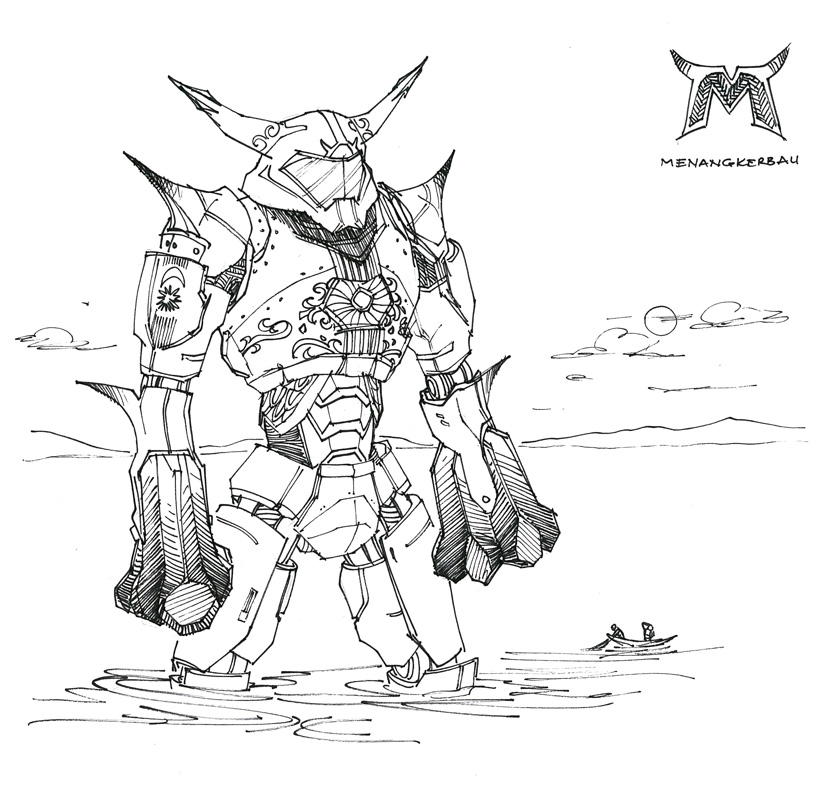
Raksasa
Little data has been publicly released on the raksasa, but eyewitness and news reports suggest that the ones entering South East Asian and Malaysian waters differ from the kaiju invading other parts of the world in terms of size, stealthiness, and preference for remaining in aquatic environments. While their damage to land areas is less severe, the potential loss of oil rigs and other resources was a major factor in driving the Pemburu program to completion.
Known Raksasa
The following is a list of raksasa spotted/engaged with in the South East Asian region.
- Guppy
- Highly elaborate fin system.
- Toyol
- Tiny and devious.
- Mastiff
- Surfaced, but fled back out to the South China Sea; little known beyond its facial structure.
- Eelkind
- Only two limbs, but was an excellent swimmer.
- Dodol
- Coloured like dodol, emitted a stench similar to the durian's.
- Tempoyak
- Reminded the pilots of the pink stuff.
- Gostan
- Two heads on either end. Oddly unable to execute turns.
- Cincai
- Named because it looked like it was put together without much care.
- Semut
- Named after its feelers and crawling movement.
More information, including images of the raksasa, will be added when available.
Notes
If you know me, you'll also know that there are hidden things for you to discover on this page. Hor, now suddenly want to scroll back up, hah?
Thanks and acknowledgements to L.L., Y.J., and K.T.M. for various ideas that I incorporated, directly or indirectly, into this page.
The pilots' names had to be unconventional (following Pacific Rim), and the Pemburu names were a golden opportunity to be as punny as possible - my apologies if my preferred brand of humour isn't very amusing to you.
I deliberately set up the pilot backgrounds to reflect relationships not highlighted in the movie - a teacher-student, good friends, and a husband and wife. Naturally, with all teams Malaysian, there had to be a tiger somewhere in it. And why not a favourite national sport? Or a local culture?
So why do this? Beyond entertaining myself and some friends, I'd like to speak more seriously about the need for Malaysians to tell Malaysian stories. There's no point wishing for Hollywood to produce movies that will depict our culture in a responsible and respectful light - not going to happen any time soon. Plus, one rule of art is that you should make work about what you know - which might encompass cultures, communities, history, stories - because you'll be able to depict it more accurately and with more detail than someone who's unfamiliar with it. There's a big difference between someone who grew up eating cendol writing a story about cendol, and a foreign concept artist who's only seen photos and descriptions of it online trying to create a depiction of it. Putting a Malaysian spin on a foreign property is hardly the way to go about it; I did this for fun. But I'm not stopping here.
Also, I just really wanted to see a giant robot play badminton.
Back to Cakar Ayam Comics.